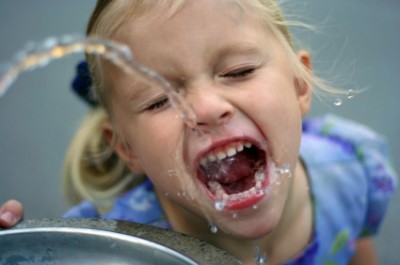 Consider the following facts:
Consider the following facts:
* Your speed on a bike decreases about 2% for each 1% of body weight lost through dehydration
* By the time you feel thirsty, you can already be at 2% body weight loss
* A 3% weight loss indicates dehydration has occurred
* Loss of fluid during exercise varies, but averages about 34 ounces per hour (3x that much in hot and humid conditions!)
* Hyponatremia, which is just as dangerous as dehydration, is a term used to describe "water intoxication" and can occur with excess water intake
* Acclimatized individuals who are used to training in hot climates or hot rooms can reduce fluid loss by up to 50%
Based on these facts, it would pretty important to make sure your indoor cycling class knows all about proper water intake.
After you”™ve introduced the facts above, teach your class the proper formulas and rules for determining regular daily hydration and exercise hydration:
* Divide your weight in half to determine the ounces of water you should drink per day. So a 160 pound cyclist would consume about 80 ounces of water, or 10 8 ounce servings.
* During exercise, the goal should be to consume about17-25 ounces per hour, or around 4-8 ounces every 15-20 minutes. A typical large water bottle is 20-25 ounces.
* Before a long exercise session, such as a multi-hour spin class or trip to the gym, the goal should be to consume 17-25 ounces per hour for 2-3 hours leading up to event (always taper off consumption about 20 minutes before to eliminate “stomach sloshing”.
* Over 28 ounces per hour can cause water dilution in the blood, which disrupts normal cellular metabolism and physiology, often with dangerous consequences, such as swelling around the brain. High-end intake above these values should only occur during exercise in hot and humid conditions.
There are a few other good quick tips to share with your class, that they”™re sure to appreciate:
* To avoid taking in too much water, you can combine hydration with doses of external water to control heat stress, such as squirting some cold water over your head.
* For people who tend to sweat and cramp excessively, glycerol supplementation can help maximize water storage.
* Cold water is absorbed more rapidly than warm water
* Pay attention to urine color - pale to light yellow is optimal
* You can lose up to a pound in glycogen, fat and muscle tissue during a 3+ hour training session, so account for this when re-hydrating, or when weighing yourself after exercise to see how much you”™ve lost
* Remember...you still evaporate water in cooler training environments!
No discussion of water would be complete without emphasizing that liquid compounds that are full of fructose, glucose or artificial colorings and sweeteners are not to be considered normal hydration methods, and should only be consumed when completely necessary, such as during a multi-hour training session during which calories are necessary.
You should also emphasize to your class the importance of choosing clean, filtered water, and avoiding heavy consumption of water from plastic bottled sources, especially in the heat.
In Part 5 of this series, we”™ll cover the other crucial aspect of hydration: electrolyte intake.
- Tri-Lingo 101 — Part 1: Common Triathlon Swim Terms - September 4, 2019
- Tri-Lingo 101 — Part 5: Common Triathlon Race Terms - March 16, 2011
- Tri-Lingo 101 — Part 2: Common Triathlon Bike Terms - February 13, 2011

Hello –
My name is Frank, and I’m writing from Global Ride Productions (www.globalride.net). We make virtual cycling training DVDs for indoor cycling. As a cycling blogger, we thought you might be interested in writing a review of our product. We are willing to send you one of our Italy DVDs, something we sell on our site for $30 plus shipping, in exchange for you writing a review. You don’t have to send the DVD back — it’s our thank you for helping spread the word about a new approach to training.
Our virtual cycling DVDs are different from any others you may have tried. We travel to a new country every year, have multiple coaching tracks on every DVD, licensed music, and bonus yoga, pilates or strength training sessions designed for cyclists at the end of every ride. They’re a great product and we just want to spread the word.
Also, If you are interested in coaching one of these for an upcoming project, please let us know as well. We are always looking for new voice/coaching talent — the main ingredients are cycling knowledge, enthusiasm and a decent microphone setup. In exchange for coaching, we give you super exposure on our website, in the credits, and even in the navigation menu of the DVD itself.
If you’d like to do a review, or be considered for coaching, just shoot me back a message with a mailing address and we can discuss it.
Please drop me a line if you want the DVD.
Thanks!
Frank
Is this offer applies for everyone who wants to introduce imaging and virtual training in his IC classes and want to test your product? I’ll be interested for a sample. thanks
if this was for me, just send me an e-mail: ben@bengreenfieldfitness.com
This is an interesting post. Calotren can be taken regularly along with plenty of fruits and vegetables. But the effects can be observed over a long period of time. It is pointless to expect the results to be obvious within a few days of taking the drug. The best thing about Calotren is that it makes fat-loss a completely natural process. You have to take healthy food and exercise a lot besides taking Calotren.